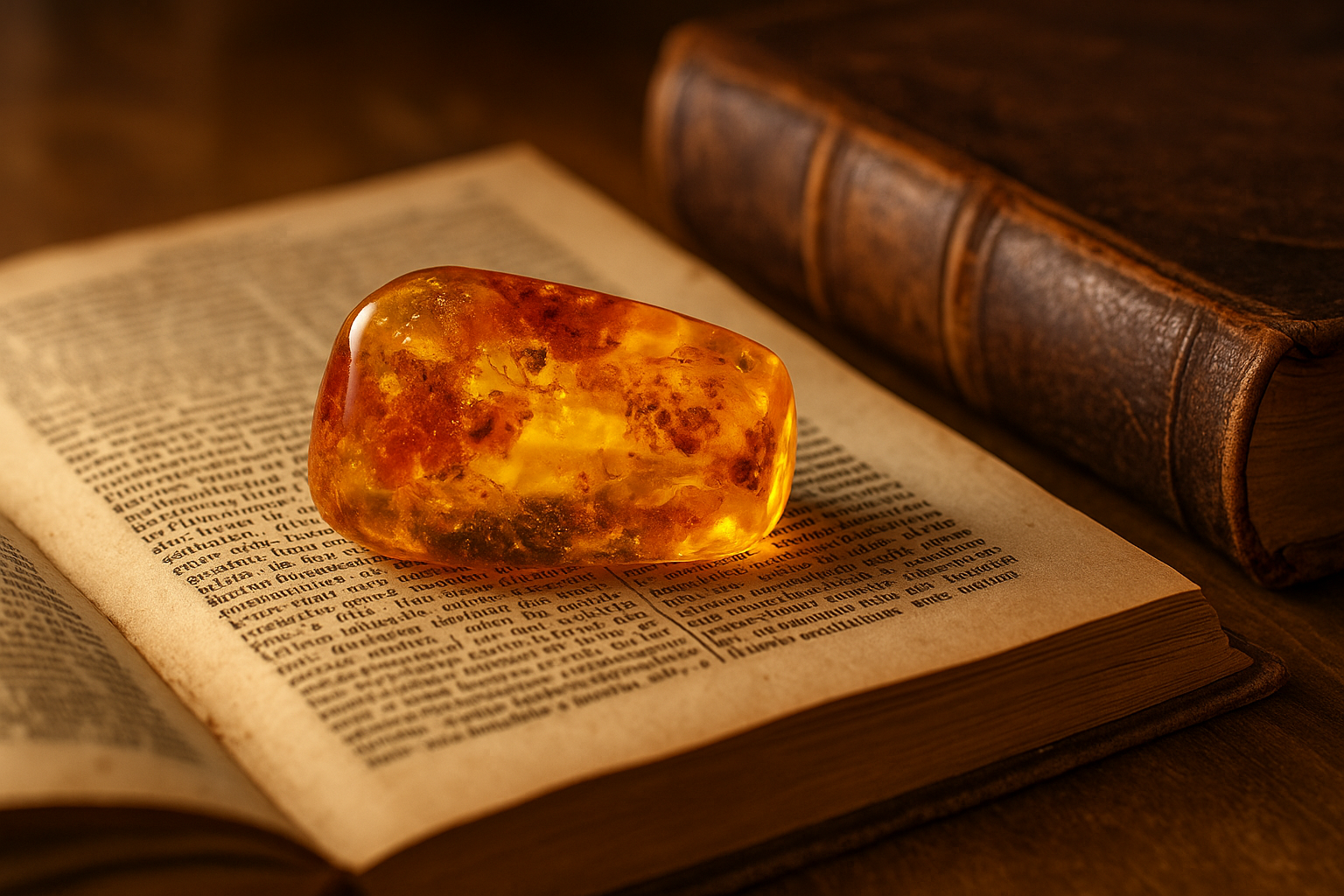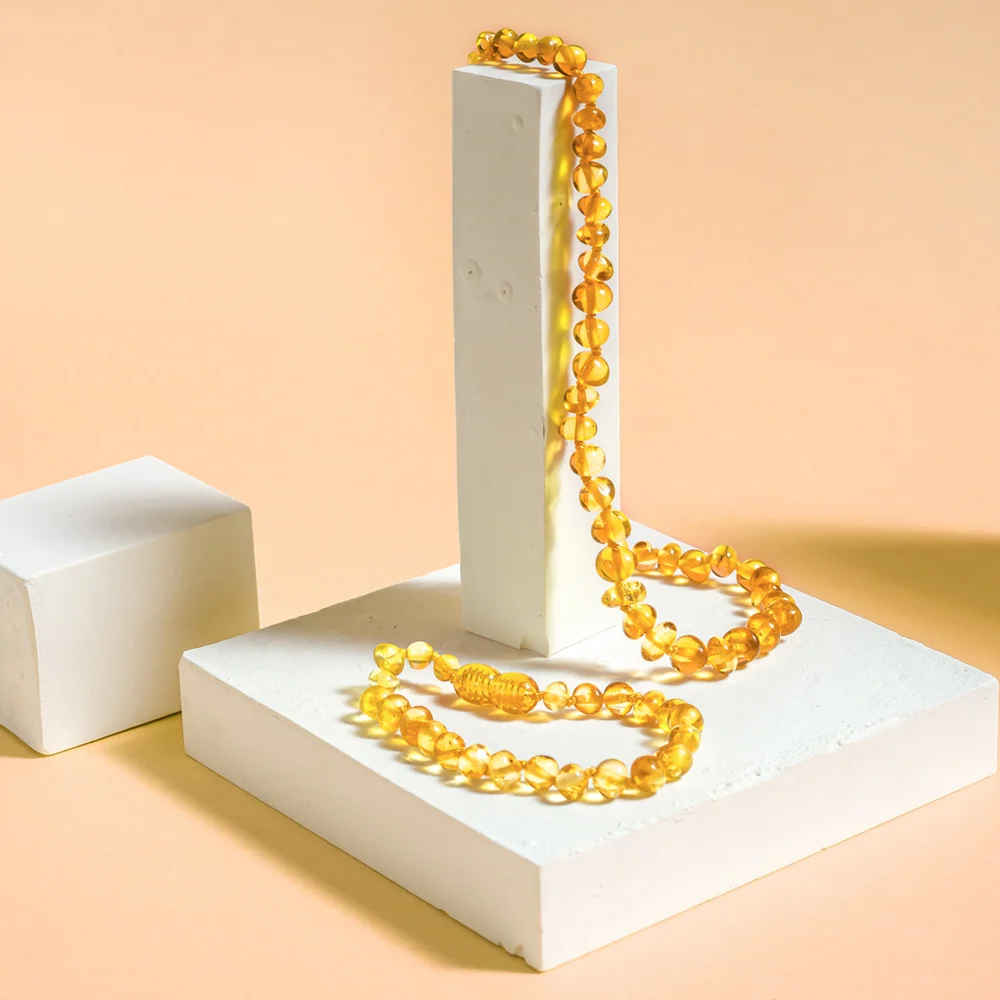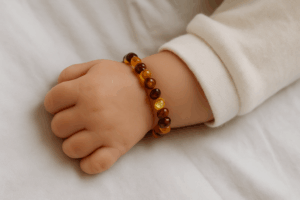For thousands of years, people have been drawn to the warm glow and healing energy of amber. Among all types, Baltic amber stands out as the most revered—not just for its beauty, but also for its historical, medicinal, and spiritual significance. But have you ever wondered: what is Baltic amber, and why has it remained so important for so long?
In this article, we’ll explore the fascinating journey of Baltic amber, from ancient forests to modern wellness practices. Along the way, you’ll learn how old is Baltic amber, why it’s valued for health, and how it evolved into the beautiful amber necklaces and amber bracelets we see today.
What Is Baltic Amber?
Baltic amber is a fossilized resin that originates from ancient pine trees in the Baltic Sea region. Unlike synthetic resin or tree sap, amber forms over millions of years as natural resin undergoes polymerization and hardens into a translucent gem-like substance. It is completely organic and rich in succinic acid, a compound known for its anti-inflammatory and analgesic properties.
So, what is Baltic amber, exactly? It’s not just a gemstone or a piece of history—it’s a natural substance that carries millions of years of environmental memory and healing energy. It is often yellow-orange but also appears in hues of red, green, brown, blue, and white. This variety makes it both therapeutically useful and aesthetically desirable.
How Old Is Baltic Amber?
The origin of Baltic amber dates back over 44 million years, making it one of the oldest and most fascinating natural materials still used today. Most of it was formed during the Eocene epoch, when giant forests of ancient conifer trees produced vast amounts of resin in response to environmental stress.
This resin would eventually fossilize under layers of earth and water, creating the amber deposits now found along the coasts of Lithuania, Latvia, Estonia, Poland, and Russia. Some pieces of amber even contain ancient insects, flowers, and pollen—tiny time capsules preserved inside golden stone.
Baltic Amber in Ancient Civilizations
Long before modern science could identify succinic acid, ancient cultures revered amber for its healing and protective powers. The ancient Greeks referred to it as “elektron,” and believed it had magical properties. Hippocrates, the father of medicine, was among the first to record amber’s therapeutic uses as early as 460 BC.
In ancient Rome, amber necklaces and amulets were worn by warriors for protection and courage. Amber powder was mixed with honey or water to create tinctures for fever, inflammation, or mental disturbances. The Egyptians buried amber in tombs to guard souls in the afterlife.
These early practices highlight the belief that amber was more than a decorative material—it was a bridge between the earthly and spiritual realms.
Amber’s Role in Medieval and World War II Europe
During the Middle Ages, amber remained a valuable commodity, often traded along the Amber Road, a key route connecting the Baltic to the Mediterranean. Medieval apothecaries used amber powder in tonics and ointments. Royal courts used amber as a status symbol.
Fast-forward to World War II, amber saw a surge in medicinal use in Germany. Parents began to use amber necklaces to soothe teething pain in infants, believing the warm skin contact released therapeutic oils. That practice laid the foundation for modern amber teething jewelry.
How Amber Necklaces and Bracelets Are Made?
The transformation of raw amber into wearable art is a process of craftsmanship and care. Amber is gently harvested from natural deposits or gathered from Baltic Sea shores. Artisans then sort, cut, and polish the amber into smooth, uniform beads.
These beads are strung into various designs, including:
- Amber necklaces: worn around the neck for maximum skin contact
- Amber bracelets: stylish and convenient for everyday wear
While adults often choose these for wellness or fashion, parents also turn to amber for their children’s health—especially during the difficult teething stage.
When worn against the skin, the body’s warmth helps release small amounts of succinic acid, which may then be absorbed into the bloodstream. This gentle process is believed to provide natural relief from pain, inflammation, and anxiety.
Why People Wear Amber Jewelry Today?
Modern science continues to explore the properties of succinic acid, but many users swear by the benefits they experience when wearing amber jewelry. Let’s take a look at some of the most commonly reported advantages:
✨ For Babies:
- Teething relief
- Calmer sleep
- Less drooling and fussiness
✨ For Adults:
- Reduced neck or joint pain
- Better focus and reduced stress
- Natural thyroid support
✨ For Everyone:
- An elegant accessory with purpose
- A link to ancient wellness traditions
It’s no longer just about aesthetics. Amber necklaces and amber bracelets are worn by people seeking natural, low-intervention wellness practices that fit into their everyday lives.
Baltic Amber in Global Traditions
While the Baltic region is the richest source of amber, its use spans across many cultures and continents. In traditional Chinese medicine, amber—known as “Hu Po”—is used to calm the mind and soothe the spirit, often as a powdered remedy for anxiety and insomnia. This aligns closely with what Baltic amber is good for in modern wellness: emotional balance and stress relief.
Among Siberian tribes, amber was worn as amulets to ward off evil spirits and offer spiritual protection. In the Middle East, it was burned as incense during rituals, believed to purify energy and connect the physical and spiritual worlds.
From Asia to Europe and beyond, amber’s role in healing, protection, and ceremony shows that amber necklaces and amber bracelets carry a truly global legacy—one rooted in tradition, spirituality, and holistic wellness.
Craftsmanship and Cultural Heritage
Each piece of Baltic amber jewelry is more than a simple accessory—it represents generations of artistry, culture, and tradition. In Lithuania, Poland, and other Baltic nations, amber craftsmanship is considered a form of living heritage. Local artisans continue to use centuries-old techniques to cut, polish, and hand-string amber beads, often passed down through families as a source of regional pride.
This meticulous process reflects not only dedication to quality, but a deep respect for nature and cultural identity. Unlike mass-produced fashion items, authentic amber necklaces and amber bracelets are often made in small workshops, where each piece is carefully shaped to enhance its natural beauty and healing properties.
By choosing handcrafted amber jewelry, you’re not just investing in a wellness tool—you’re supporting traditional craftsmanship and helping preserve a cultural legacy that spans thousands of years. Every bead tells a story, linking you to ancient forests, historic trade routes, and a heritage of natural healing still cherished today.
How to Identify Genuine Baltic Amber?
With rising popularity comes the risk of imitation. Genuine Baltic amber should:
- Feel warm to the touch
- Show imperfections or natural inclusions
- Float in salt water
- Release a pine scent when heated
Always purchase from trusted sources that provide certificates of authenticity and clear origin information. True Baltic amber will contain a higher concentration of succinic acid than amber from other regions.
Why Amber Is a Sustainable Wellness Choice?
In an age where more consumers are actively seeking eco-conscious alternatives, Baltic amber stands out as one of the few wellness materials that is both naturally effective and environmentally responsible. Unlike gemstones or precious metals that demand deep mining, heavy machinery, and chemical refinement, amber is often gently gathered from shallow soil layers or washed ashore by the Baltic Sea—requiring minimal ecological disruption.
This low-impact harvesting method significantly reduces pollution, energy use, and habitat destruction, making amber one of the most sustainable options in the jewelry industry. In fact, many amber necklaces and amber bracelets are handcrafted by local artisans who use traditional tools and techniques, further minimizing the carbon footprint associated with mass production.
Moreover, amber is biodegradable, non-toxic, and naturally formed—requiring no artificial coloring or synthetic additives. It pairs well with other natural materials such as cotton, hemp, or silk, making it a perfect match for eco-friendly lifestyles and sustainable fashion enthusiasts.
Choosing Baltic amber means supporting responsible sourcing, preserving cultural heritage, and investing in a wellness product that reflects care for both the body and the planet. It’s more than just a beautiful accessory—it’s a quiet but powerful commitment to conscious living.
Final Thoughts: Embrace the History, Experience the Healing
From ancient warriors and Greek physicians to modern wellness seekers, the story of Baltic amber spans centuries—and it’s far from over. With its warm tones, fossilized beauty, and health-enhancing potential, amber jewelry is more than a trend—it’s a tradition backed by history and beloved for its benefits.
Whether you’re drawn to its natural healing powers, or its timeless appeal, now is the perfect moment to bring a piece of this legacy into your life.
👉 Ready to experience the benefits of Baltic amber firsthand?
Explore our curated collection of authentic amber necklaces and amber bracelets, handmade from 44-million-year-old Baltic amber. Whether shopping for yourself or a loved one, you’ll find a meaningful gift that blends beauty with purpose.
Start your journey to natural wellness today—discover the power of Baltic amber.
Sources:
Succinic Acid—A Natural Compound With Significant Anti-Inflammatory Properties – National Center for Biotechnology Information (NCBI)
https://www.ncbi.nlm.nih.gov/pmc/articles/PMC3346402/
Amber | Fossil Resin – Encyclopaedia Britannica









